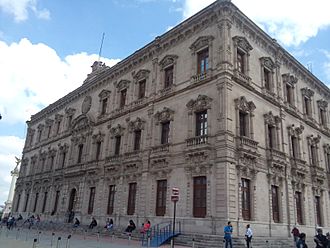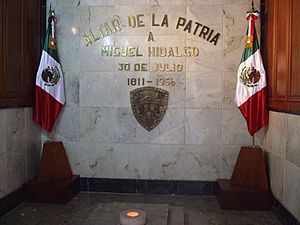Government Palace of Chihuahua facts for kids
Quick facts for kids Government Palace of Chihuahua |
|
|---|---|
 |
|
| General information | |
| Location | Chihuahua, Mexico |
| Coordinates | 28°38′21″N 106°4′24″W / 28.63917°N 106.07333°W |
The Government Palace of Chihuahua (or Palacio de Gobierno de Chihuahua) is a really old and important building in Chihuahua, Mexico. It's right in the heart of the city! This palace is special because it's where the governor of Chihuahua state works. It also has a memorial for Miguel Hidalgo, who is known as the "Father of the Country." He was executed by a Spanish firing squad on July 30, 1811. The "Altar of the Fatherland" is exactly where he died.
Contents
A Look Back in Time: History
From College to Palace
A Jesuit school used to stand on this spot a long time ago. In 1767, the Society of Jesus (the Jesuits) had to leave New Spain (which is what Mexico was called then). So, the building was empty for a while.
Later, in 1790, it became a military hospital. In 1859, the government took over the building. This happened after new laws were passed by President Benito Juárez.
Building a New Palace
The old building was torn down in 1878. Work on the new Government Palace started in 1881. Governor Luis Terrazas was in charge. Engineer-Architect Pedro Ignacio Irigoyen led the building project.
It took almost ten years to build! On September 11, 1891, the palace was ready. It officially opened on June 1, 1892. The palace first had two floors and was made of limestone in a neoclassic style.
Fire and Fresh Start
On June 21, 1941, a big fire badly damaged the palace. It burned much of the inside. But don't worry, it was completely fixed up! A third floor was even added. The building reopened in 1947.
Walls That Talk: The Murals
In 1959, Governor Teofilo Borunda decided to decorate some of the inside walls. He wanted murals that showed the history and economy of the state. Muralist Aarón Piña Mora was chosen for the job.
The first mural he painted showed the death of Miguel Hidalgo. When President Adolfo López Mateos visited in 1962, he suggested that more murals be painted. Now, the entire first floor and part of the second floor are covered with these amazing murals. They tell the story of Mexico!
Palace Style: Architecture
The Government Palace is designed in the neoclassic style. This means it looks like ancient Greek and Roman buildings. The first floor has Doric order columns. The second floor has Ionic order columns. The third floor mixes different styles.
The main courtyard, called the Patio Central, once had a sculpture. It showed the four main groups of people in the world. This sculpture was later moved to El Parque España, a park in the city.
In 2004, Governor Patricio Martinez had the palace restored. The State Coat of Arms was added. The "Four Races" sculpture was also brought back to the Central Patio. A statue of Miguel Hidalgo was put up too.
Pictures of the Palace
-
A mural showing the building of the Cathedral of Chihuahua.
See also
 In Spanish: Palacio de Gobierno de Chihuahua para niños
In Spanish: Palacio de Gobierno de Chihuahua para niños










